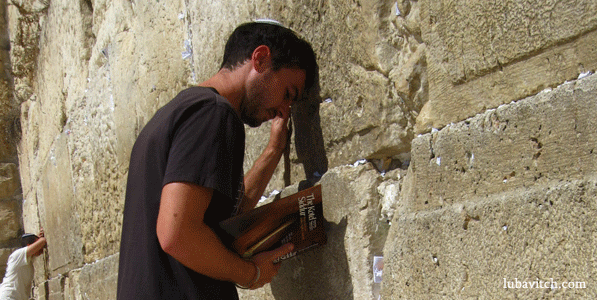(lubavitch.com) On a recent Mayanot Birthright trip to Israel, David Foldvary found himself ill at ease with the thought of praying at the Western Wall one Friday night. “I haven’t used a siddur much before. I didn’t know if I’d be able to find my place,” said Foldvary, a history teacher.
The Western Wall is a popular destination for tour groups like Birthright, and visitors are told that this is Judaism’s holiest site. But the lack of a central, organized service combined with a multitude of little ad hoc congregations, and the fact that there is no rabbi or cantor to keep participants engaged can make the experience overwhelming, even alienating for some.
The Kotel Siddur, edited by Rabbi Zalman Goldstein, director of the Jewish Learning Group; Rabbi Shlomo Gestetner, director of Mayanot Israel; and Martin Glatt of Johannesburg, SA, seeks to address the needs of the first time visitor.
In addition to comprehensive translations and transliterations, the Kotel Siddur offers explanations and insights into the spiritual meaning of the site. Concise essays answer many questions first time visitors to the Kotel may feel uncomfortable asking, such as why Jewish people have cared, cried and fought for this pile of mortar, bricks and leafy henbane for so many centuries.
With icons that indicate when to stand, sit and bow, and notes preceding the paragraphs that help frame the place of the various prayers in Jewish history, the siddur is a helpful tool for those with limited or no Jewish education. For Foldvary, the Kotel Siddur made his own experience at the Western Wall that much more meaningful and engaging.
“We wanted to make the Kotel a more user friendly environment for the uninitiated,” said Rabbi Gestetner.
Lee Lefkowitz, 23, a law student from New York City, used the Kotel Siddur to brush up on his Sunday school Hebrew.
“I do read Hebrew, but I used the transliteration to check if my pronunciation was correct,” said Lefkowitz, who was struck by his experience at the Kotel.
“I didn’t know there would be different groups of people praying. I didn’t know how animated it would be. People were dancing, singing.”
The Kotel Siddur is now in its second printing, which will include some 10,000 paperback and 2,000 hardcover copies. Israel tour groups and study centers have been quick to purchase the prayerbooks, which sell at cost price, about $2 apiece. Nitzana Educational Community, NCSY – Israel, Jewish Agency Israel Experience, and the Jewish Women’s Renaissance Project are among the groups that bulk ordered the siddur.
To appeal to groups of different backgrounds, the text includes Sephardic, Ashkenazic and Ari variations on the liturgy. “We tried to make it a siddur for the Jewish people as a whole,” said Rabbi Gestetner.
For Glatt and his wife Melanie, the Kotel Siddur is the couple’s latest project aimed at helping Jewish people gain a better understanding of their personal relationship with the Kotel. The couple’s work began ten years ago, when they saw a photographer assaulted at the Kotel for attempting to set up his camera on Shabbat.
“My wife and I were very unhappy to see an altercation in a spiritual place,” said Glatt.
Determined to help visitors understand the holiness of the Kotel, they turned to Chabad. “The only group I knew that had a presence at the Kotel was Chabad’s tefillin stand,” said Glatt. The couple’s local Chabad rabbi, Rabbi David Masinter of Benmore/Riverclub in Johannesburg, South Africa, put Glatt in touch with Rabbi Gestetner, who helped the Glatts work their way through the bureaucracy in order to post informational signs that would explain the basic traditions of Shabbat and prayer, as well as other customs associated with the Kotel. The couple also put together a comprehensive brochure describing the significance of the Wall, which is available at the entrance to the Kotel, in seven languages.
An expanded edition of the siddur with a guide to the Shabbat blessings and songs is nearly ready. Future publications may include translations of the Kotel Siddur as well as a weekday edition. The aim of these projects, said Glatt, is to give visitors a better sense of what the Kotel is all about.

Maureen Asper
I’m hoping this will be made available for those who are not Jewish. As a Catholic i fully recognize our Jewish roots and wish to learn more about this beautiful religion.